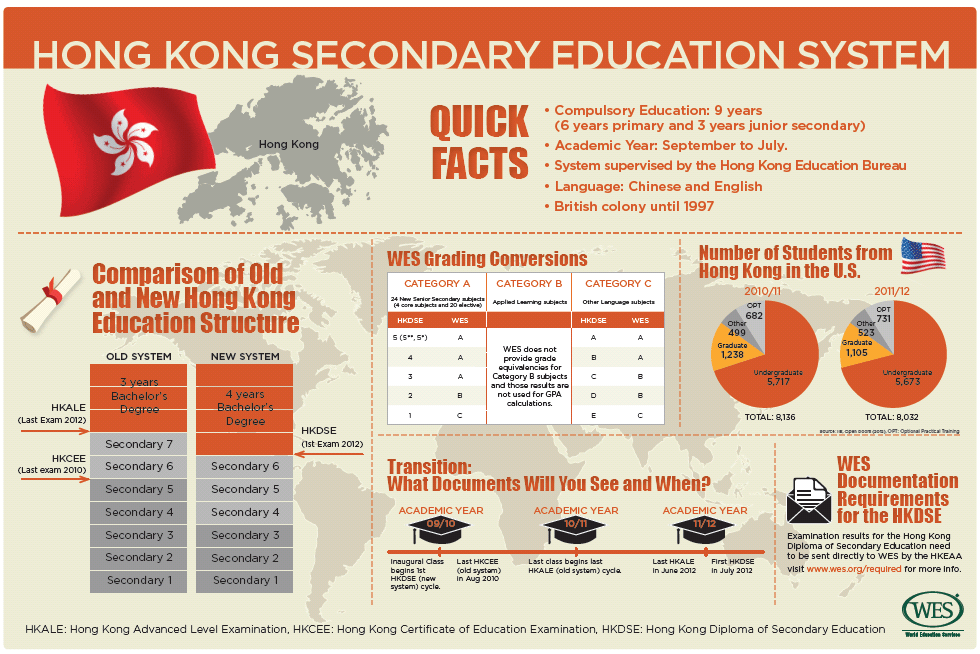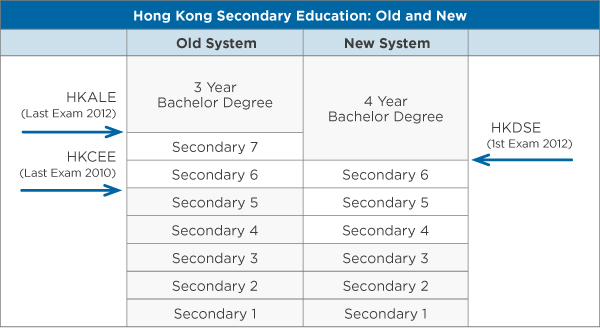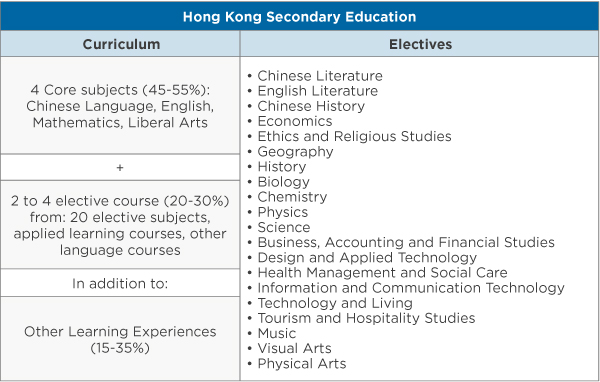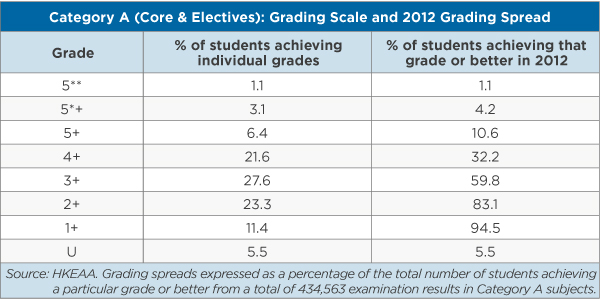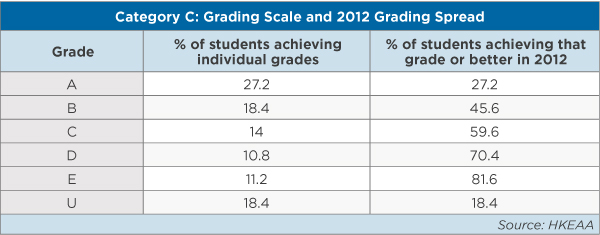Yuki Inoue, Asia-Pacific Group Leader, WES, Nick Clark, Editor, World Education News & Reviews
In this article, we offer an introduction to Hong Kong’s New Senior Secondary (NSS) academic structure and curriculum [2], in addition to the new credentials and transcripts from the Hong Kong Diploma of Secondary Education [3] (HKDSE), first issued in the fall of 2012. This profile builds on an earlier webinar by Yuki Inoue, WES’ Asia-Pacific Group Leader.
A New Hong Kong Secondary Curriculum
The new Hong Kong secondary curriculum was first introduced at the Secondary 4 level (Grade/Year 10) in September 2009. The new graduating examination, the Hong Kong Diploma of Secondary Education Examination was administered for the first time in the summer of 2012 at the same time that a second graduating class of students was taking the final set of A-Level examinations. The transition from 7 years of secondary education to 6 years resulted in a double cohort of graduating students in 2012. WES began seeing and evaluating the new HKDSE transcripts this past fall.
Students no longer take the intermediate Hong Kong Certificate of Education Examination [4] (HKCEE) at the end of Secondary 5. Instead, they take one set of examinations at the end of their final upper secondary year (Secondary 6), after six years of uninterrupted junior and senior secondary education (3+3). The move to eliminate the intermediate HKCEE exam was designed to increase the number of students completing the full secondary program, and to create more time for students to enrich their learning experiences by taking non-academic courses. Formerly, only students achieving satisfactory grades in the HKCEE were allowed to continue on to take A-Levels (about one-third of HKCEE test-takers), a requirement for university admissions. Compulsory education remains at nine years.
The new HKDSE curriculum consists of four core subjects (Chinese language, English, mathematics and liberal studies). In addition, students are required to take up to four elective courses from a total of 20 different subject areas, along with a number of ‘other learning experiences.’
The new curriculum is assessed against a set of subject- and level-specific learning outcomes, with the aim that student results indicate a level of knowledge and skills acquisition relevant to further study and the job market. Grades are awarded irrespective of the performance of other candidates taking the examination. Therefore, the learning descriptors [5] against which students are graded allow stakeholders to understand the level of skills and knowledge that candidates have in a given subject when they achieve a particular level of performance.
2012 HKDSE Examination Data
As noted above, all students can now access the full six years of secondary education, meaning an increase in the number of students sitting for the HKDSE versus the number that have traditionally taken A-Levels. In the 2012 double-cohort year, approximately 73,000 students took the HKDSE Examination (26,500 met the ‘3322’ university entry standard), while 41,500 took the final set of A-Level examinations (18,725 met university-entry standards), according to official figures from the Hong Kong Examinations and Assessment Authority [7].
A total of 64,450 HKDSE students applied through the Joint University Programmes Admission System [8] for just 14,800 undergraduate places at nine bachelor-level institutions; a similar number of places were reserved for A-Level candidates meaning that some 34,000 higher education candidates were left without a university place.
Increased International Mobility
With an increased number of senior secondary graduates competing for the same number of university places in the post A-Level era, more Hong Kong students are expected to be looking abroad for higher study opportunities in the future. This means that Hong Kong has the potential to become an increasingly attractive source of students for institutions recruiting internationally, especially when one considers English-language ability and comparative secondary standards in Hong Kong.
The interest in overseas study is likely to be especially pronounced in the first few years of transition, as parents are reportedly quite nervous about the changes and are actively looking at alternative options for their children’s secondary and tertiary study. In addition, many observers expect the double-cohort year to lead to an increase in overseas enrollments that will continue beyond 2012 thanks to improved access to upper-secondary studies under the HKDSE.
To that point, the Hong Kong authorities have been highly proactive in the build-up to 2012 by ensuring that the new secondary and undergraduate structures and curricula are being understood and recognized internationally.
Britain’s Universities and Colleges Admissions Service [9] (UCAS) conducted an in-depth study [10] of the new secondary curriculum to benchmark standards against its GCE A-Level system, placing the 24 core and elective subjects of the HKDSE in the UCAS Tariff system, while also allowing for a comparison of standards between the HKDSE and other international qualifications.
Other comparative studies have been conducted by authorities in Australia and New Zealand, and a list of HKDSE-accepting universities [11] with admission requirements is on the Hong Kong Examinations and Assessment Authority (HKEAA) website. A similar list of HKDSE-accepting U.S. and Canadian universities [12] is also available on the HKEAA website. Universities that haven’t already done so are encouraged to indicate their admission requirements for students with HKDSE qualifications.
Details of World Education Services’ evaluation of the new curriculum will be discussed below.
The number of Hong Kong students in the United States has held reasonably steady over the last 10 years at between 7,500 and 8,500 students, according to the IIE’s Open Doors data [14], ranking Hong Kong as a consistent top 20 source of international students.
Given the historical ties, it is no great surprise that the United Kingdom welcomes the greatest number of students from Hong Kong of any host country, with 10,440 there in academic year 2010/11 (sixth biggest source), according to data from Britain’s Higher Education Statistics Agency [15].
There were just over 7,000 Hong Kong students in Australia, across all levels, in 2010, according to Australia Education International [16].
It should also be noted that many citizens in Hong Kong have dual citizenship – most commonly British, Canadian, or Australian – and as most students tend to use their non-HK citizenship when studying abroad, the number of students from Hong Kong in the United States or the United Kingdom is likely higher than official statistics show.
Secondary Education in Hong Kong
As a former colony of Britain, the Hong Kong education system has been heavily influenced by the British model. Under the old HKCEE/HKALE system, students took the Hong Kong Certificate of Education Examination (HKCEE) at the end of Secondary 5 (11 years of primary and secondary education), and the Hong Kong Advanced Level Examination [17] (HKALE) after a further two years of sixth form schooling (6+5+2). The HKALE was required for application to university-level studies.
The New Senior Secondary (NSS) structure, which shortens secondary education by a year to six years, was introduced to an inaugural class of Secondary 4 (Year 10) students in September 2009. In September 2010 the last class of Secondary 6 students began the last two-year HKALE cycle, resulting in the 2012 double cohort.
In deviating from the UK model, the NSS is now more in line with the systems of China (among other Asian nations), the United States and Australia. Under the new system, there is only one public examination, the HKDSE Examination, at the end of Secondary 6, which is required for application to university-level studies. There is no longer a qualifying examination to enter upper secondary. The new system maintains six years of primary schooling, followed by three years of junior secondary and three years of upper secondary (6+3+3).
The structure of the bachelor degree also changed with the beginning of the 2012/13 academic year, from a three-year program to a four-year program. No more three-year degrees will be offered after 2013.
New Academic Structure
Curriculum
Students can also take applied learning courses as part of their elective classes, and some schools offer additional foreign languages that students can also choose from.
In addition to core courses and elective courses, students are required to complete what are known as ‘other learning experiences.’ These include: Moral and civic education, community service, career related experiences, aesthetic development, and physical development.
Medium of Instruction
At the junior secondary level (Secondary 1 – 3), schools have the option to adopt Chinese as the language of instruction for teaching non-language subjects, with the option to conduct up to 25 percent of classroom activities and research in English (excluding English language classes).
Other schools at the secondary level may choose to offer non-language instruction exclusively in Chinese or English. English-language schools are more common at the senior secondary level.
Main Changes in Content
Although students are not required to choose a specific stream or focus in their senior secondary years under the new system, electives can be chosen in such a manner to develop what might be considered a concentration.
Detailed curriculum information is available from the HK Education Bureau at: http://334.edb.hkedcity.net/EN/curriculum.php [22]
Examinations
The Hong Kong Diploma of Secondary Education is the basis for entry to higher education, replacing the HKALE. The subject examinations are taken after six years of secondary education, and they are administered by the Hong Kong Examinations and Assessment Authority.
Grading
For the purposes of grading, core and elective courses are separated from applied learning courses and other language subjects.
The majority of students take 6 to 7 HKDSE subjects (4 core and 2 or 3 electives), and a maximum of 8 subjects. The applied learning subjects (ALS) are electives developed by schools and approved by the HK Education Bureau. Candidates are required to take eight to 10 assessment tasks as part of their ALS courses.
HKDSE Grading Scales and Grading Spreads
There are three different grading scales under the new HKDSE system, one for each category.
Category A Subjects
Notes:
- 5 is the highest score, but as university entry is so competitive the authorities introduced two new starred categories to help micro-filter top students.
- Students with the best Level 5 performances are awarded 5**
- Those with the next best performances are awarded 5* (for selection purposes)
- U: Unclassified
Category B
Notes:
- Students are internally assessed by teachers at the institution attended.
- After moderation by the Hong Kong Examinations and Assessment Authority to ensure that there are no major discrepancies in grading among schools and teachers, the final results are posted.
Category C
Notes:
- Examinations for category C subjects are conducted by the UK’s Cambridge International Examinations Authority.
Admissions Requirement for University Study
Four core subjects are mandatory for university entry and students are required to obtain a minimum score of 3 in Chinese and English and 2 in mathematics and liberal arts subjects. Additionally, admitting institutions will decide if they require one or two elective subjects from applicants, and the grades that must be obtained.
Admission Requirements for Associate/Diploma Study
Students must score a minimum of 2 in five HKDSE subjects (four core, one elective), including Chinese and English.
Notes:
- In 2012, examinations for the HKALE and HKDSE were both administered, meaning that receiving institutions can expect to see 2012 degrees from both structures.
International Recognition of HKDSE
The Universities and Colleges Admissions Service (UCAS – UK) considers the HKDSE equivalent to the UK’s GCE A-Level.
Australia Education International (AEI) considers the HKDSE equivalent to the Australian Senior Secondary Certificate of Education.
WES Equivalency
World Education Services evaluates the HKDSE as equivalent to a high school diploma from a university preparatory program in the United States.
WES Documentation Requirements for the HKDSE
For students that haven’t yet taken the exam, but need an evaluation report, WES requires transcripts from the three years of upper secondary to be sent directly from the school attended.
WES Grade Conversions
Category A
Based on research conducted by UCAS, WES offers the following preliminary grade equivalencies.
UCAS Tariff for the HKDSE: http://www.ucas.ac.uk/documents/tariff/tariff_reports/hkdipreport.pdf [31]
Category B
WES does not provide grade equivalencies for Category B subjects and those results are not used for GPA calculations.
Category C
As Category C subjects are examined by the Cambridge International Examinations board, WES applies the same grade conversions as it does for the UK General Certificate of Education A-Level, as denoted above. In addition, WES does not include Category C results in the GPA calculation, as they are not among the three requirements for the HKDSE.
GPA Calculations
In calculating GPA equivalencies, WES uses only the four core subjects (Chinese, English, Liberal Arts and Mathematics).
What if Students Have Not Received HKDSE Results?
WES recommends that institutions obtain the official academic transcript issued and sent by the high school attended, and then equate it to XXX years of elementary and secondary education depending on the number of years completed by the student.
For grading, a case-by-case analysis is required as schools use different grading scales and methodologies.
Sample Documents
This file of Sample Documents (pdf) [34] shows a set of annotated secondary credentials from both the old and new systems, beginning with two HKDSE transcripts received by WES, a draft HKDSE transcript from the HK authorities, and then samples of the HKCEE and HKALE documents.

